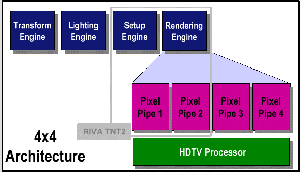 |
|
|
|
In the Forums... |
Posted: October 11, 1999 Written by: Dan "Tweak Monkey" Kennedy The World's First GPU Get ready boys and girls, here is yet another acronym for you to sink your teeth into, chew and digest. The GeForce 256 can be considered the world's first GPU. What is a GPU, you ask? A GPU is a single-chip processor with integrated transform, lighting, triangle setup/clipping and rendering engines that is capable of producing a minimum of 10 million polygons per second. As you may have guessed, GPU stands for Graphics Processing Unit. What Makes a GPU Special What's the big deal? Is this just another buzzword to clutter your mind? No, a GPU is far from just another acronym. A GPU is extremely important and revolutionary in today's graphics world because it does so much beyond what previous graphics chips could manage. By handling T&L (transform and lighting) within the graphics chip, enormous amounts of CPU usage can be spared, and therefore be directed toward other important game aspects such as AI or physics. And since T&L will be dedicated engines for their respective functions, you should anticipate incredible new lighting effects that previously would have made a game slow to a crawl. Why the TNT/TNT2 isn't a GPU Besides the lack of T&L engines, you are probably curious about the TNT's features, as compared to the GeForce 256. Maybe you're not convinced that the GeForce 256 is any better than the TNT/TNT2, other than fill rate, etc. This diagram should help you to understand what the TNT2 doesn't have, that separates it from the GeForce 256.  Click to enlarge Is that diagram a surprise? Maybe I forgot to mention that the GeForce 256 also has four pixel pipes, instead of two. So now, instead of using that good ol' equation of 2xClockSpeed=fill rate, you can use 4xClockSpeed=fill rate. Good news? I'd say so, especially for Tweak3D readers, as we learned from our last poll, since over 60% of readers overclock their video cards! Now, each MHz you add to the clock speed will literally give you double the increase in fill rate compared to overclocking a TNT/TNT2. Also, as the diagram reveals, the GeForce 256 has a new feature called an HDTV Processor, which I will explain later. You want to know the specs now, right? Read on! |
||
|
| |||
|---|---|---|---|